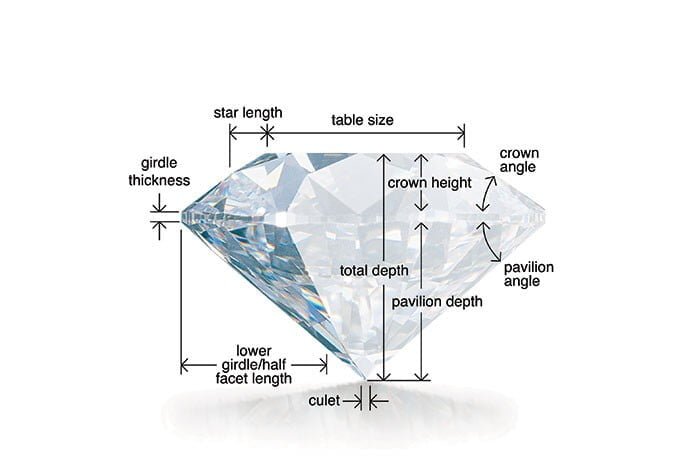The 4Cs of Diamonds
Content Directory
Color Grading

Diamond Color Actually Means Lack of Color.
Is a diamond with a color grade Z a fancy color?
No. Natural colored diamonds outside the white color range are called fancy colored diamonds, and the D to Z grades simply describe the degree of colorlessness. As for yellow or brown diamonds, they are much darker in color than Z-grade diamonds, or they take on a color other than yellow or brown.
Why does the GIA color grading system start at D?
Before GIA’s widespread adoption of the D-to-Z color grading system, there were no clear standards to define what diamond color was. From A, B, and C to Arabic numerals (0, 1, 2, 3) and Roman numerals (I, II, III), to descriptive terminology, there is no set standard and it becomes a mess. Therefore, the creators of the GIA color scale wanted to start a new system that was radically different from earlier claims. So GIA grades start with the letter D. It is now the world’s universal diamond color grading system.
Clarity Grading

Diamond Clarity Refers to the Absence of Inclusions and Blemishes
To understand diamond clarity, we must first understand how diamonds are created. Natural diamonds are the result of carbon exposed to tremendous heat and pressure deep in the earth. This process can result in a variety of internal characteristics called ‘inclusions’ and external characteristics called ‘blemishes.’
Evaluating diamond clarity involves determining the number, size, relief, nature, and position of these characteristics, as well as how these affect the overall appearance of the stone. If you are trying to determine what is the best clarity for a diamond, remember that no diamond is perfectly pure. But the closer it comes to purity, the better its clarity.
The GIA diamond clarity scale has 6 categories, some of which are divided, for a total of 11 specific grades.
- Flawless (FL) No inclusions and no blemishes visible under 10x magnification
Internally Flawless (IF) No inclusions visible under 10x magnification. - Very, Very Slightly Included (VVS1 and VVS2) Inclusions so slight they are difficult for a skilled grader to see under 10x magnification.
- Very Slightly Included (VS1 and VS2) Inclusions are observed with effort under 10x magnification, but can be characterized as minor.
- Slightly Included (SI1 and SI2) Inclusions are noticeable under 10x magnification.
- Included (I1, I2, and I3) Inclusions are obvious under 10x magnification which may affect transparency and brilliance
Many inclusions and blemishes are too tiny to be seen by anyone other than a trained diamond grader. To the naked eye, a VS1 and an SI2 diamond may look exactly the same, but these diamonds are quite different in terms of overall quality.
Cut Grading

The characteristics of a well-cut diamond are superior brilliance, fire, and scintillation
- Brilliance: Internal and external white light reflected from a diamond.
- Fire: The scattering of white light into all the colors of the rainbow.
- Scintillation: The amount of sparkle a diamond produces, and the pattern of light and dark areas caused by reflections within the diamond.
The cut grade of a diamond is determined by ratio, symmetry, and polish.
- Ratio grading:Excellent, Very Good, Good, Fair, Poor
- Symmetry Grading:Excellent, Very Good, Good, Fair, Poor
- Polishing grading:Excellent, Very Good, Good, Fair, Poor
Please note: The worst of the three grades of ratio, symmetry, and polish determines the diamond’s final cut grade.
Carat Weight

Diamond Carat Weight Measures a Diamond’s Apparent Size
Simply put, the carat weight of a diamond measures how much a diamond weighs.
The metric “carat” is defined as 200 milligrams. Each carat is divided into 100 “points”. This allows very accurate measurements to be made to the hundredth decimal place. A jeweler can only describe a diamond weighing less than one carat by its “points”. For example, a jeweler might call a 0.25 carat diamond “twenty-five pointers.” A diamond weighing more than one carat is expressed in decimal carats. The 1.08 carat stone would be described as “one point eight carats”.
All other things being equal, the price of a diamond increases with the carat weight of the diamond because larger diamonds are rarer and more desirable. However, two diamonds of the same carat weight can have very different values (and prices) depending on the diamond’s other three 4C factors: color, clarity, and cut.
While you now know what carat means, it’s also important to remember that a diamond’s value is determined using all the 4Cs, not just the carat weight.
Diamond Shape

Standard Round Brilliant Cut Diamond Structure:
- Table: The largest facet of a gemstone
- Crown: The top portion of a diamond extending from the girdle to the table
- Girdle: The intersection of the crown and pavilion which defines the circumference of a diamond
- Diameter: The measurement from one girdle edge of a diamond straight across to the opposing side
- Pavilion: The bottom portion of a diamond, extending from the girdle to the culet
- Culet: The facet at the tip of a gemstone. The preferred culet is not visible with the unaided eye (graded “none” or “small”)
- Depth: The height of a gemstone measured from the culet to the table
Diamond cut and diamond shape are two different things
Although these terms are sometimes used interchangeably, diamond cut and diamond shape have different meanings. A diamond cut evaluates a diamond’s light performance and is based on a combination of factors: proportion, symmetry, and polish (the overall surface condition of a diamond’s facets). The diamond shape is related to the outline of the diamond.
Round brilliant diamonds are our most popular shape.
